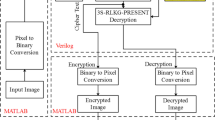Abstract
This paper proposes highly compact and high speed hardware architectures of 64-bit KASUMI block cipher for wide range of wireless applications. A novel methodology is adopted for low area KASUMI implementation employing a single combined substitution block (CSB) for S9 and S7 substitution functions in FI/FO function. The CSB performs S9/S7 transformations and re-utilizes the common combinational logic of AND and AND–XOR gates whereas computations of CSB logic expressions are performed using parallel hierarchy of ANDs/AND-XORs. This scheme substantially reduces the area generating moderate throughput values for compact KASUMI architecture. FPGA implementation with Xilinx Virtex 7 and ASIC implementation using IC Design Compiler, 0.18 µm at 1.8 V constituted 126 CLB slices/2.64 k gates having throughput values of 180/122 Mbps respectively. For high speed KASUMI implementation, the optimized combinational logic methdodology of compact architecture is extended to individual S9/S7 substitution functions and 2 × pipeline schemes are proposed. The odd and even round functions FO and FL are configured for simultaneous operations and path delays are reduced using XOR logic modifications thereby producing high throughput and high efficiency values. Hardware implementations yielded an area of 1619 CLB slices/52.7 k gates attaining throughput values of 16.9/16.1 Gbps for high speed KASUMI architecture I whereas KASUMI architecture II constituted 1847 CLB slices/59.8 k gates attaining very high throughput of 27.5/26.6 Gbps with FPGA and ASICs respectively. A detailed design and performance analysis of proposed KASUMI architectures is described.




Similar content being viewed by others
References
3GPP. (2016). Specification of the 3 gpp confidentiality and interrity algorithms; Document 2: KASUMI specifications. Resource document 3GPPTS35.202, Version 13.0.0, Release 13. Accessed Apr 10, 2017.
3GPP. (2016). Specification of the MILENAGE algorithm set: An example algorithm set for the 3gpp authentication and key generation functions f1, f1*, f2, f3, f4, f5 and f5*; Document 1: General. Resource document 3GPP TS 35.205, Version 13.0.0, Release 13. Accessed Mar 21, 2017.
Yamamoto, D., Itoh, K., & Yajima, J. (2011). Compact architecture for ASIC and FPGA implementation of the KASUMI block cipher. IEICE Transaction Fundamentals. https://doi.org/10.1587/transfun.E94.A.2628.
Yasir, Wu, N., Zhang, X. Q., & Yahya, M. R. (2017). Highly optimised reconfigurable hardware architecture of 64 bit block ciphers MISTY1 and KASUMI. IET Electonics Letters. https://doi.org/10.1049/el.2016.3982.
Shaker, N. H., Issa, H. H., Shehata, K. A., & Hashem, S. N. (2013). Design of F8 encryption algorithm based on customized KASUMI block cipher. International Journal of Computer and Communication Engineering. https://doi.org/10.7763/IJCCE.2013.V2.213.
Yasir, Wu, N., Siddiqui A. A. (2017). Performance comparison of KASUMI and hardware architecture optimization of f8 and f9 algorithms for 3g UMTS networks. In IEEE proceedings of 2017 14th international bhurban conference on applied science and technology. https://doi.org/10.1109/ibcast.2017.7868088.
Yamamoto, D., Yajima, J., & K, Itoh. (2010). Compact architecture for ASIC implementation of MISTY1 block cipher. IEICE Transaction Fundamentals. https://doi.org/10.1587/transfun.E93.A.3.
Yasir, Wu, N., & Zhang, X. (2017). Compact hardware implementations of MISTY1 block cipher. Journal of Circuits, Systems and Computers. https://doi.org/10.1142/S0218126618500378.
Kitsos, P., Galanis, M. D., & Koufopavlou, O. (2005). An FPGA implementation of the GPRS encryption algorithm 3 (GEA3). Journal of Circuits, Systems and Computers. https://doi.org/10.1142/S0218126605002337.
Rjoub, A. & Ghabashneh, E. M. (2016). Low power/high speed optimization approaches of MISTY algorithm. In IEEE proceedings of 5th international conference on electronic devices, systems and applications. https://doi.org/10.1109/icedsa.2016.7818520.
Liu, Q., Xu, Z., & Yuan, Y. (2014). High throughput and secure AES on FPGA with fine pipelining and enhanced key expansion. IET Computers and Digital Techniques. https://doi.org/10.1049/iet-cdt.2014.0101.
Mathew, S., Satpathy, S., Suresh, V., Anders, M., Kaul, H., Agarwal, A., et al. (2015). 340 mV–1.1 V 289 Gbps/W, 2090-gate nano AES hardware accelerator with area-optimized encrypt/decrypt GF (24)2 polynomials in 22 nm tri-gate CMOS. IEEE Journal of Solid-State Circuits. https://doi.org/10.1109/jssc.2014.2384039.
Satoh, A., & Morioka, S. (2002). Small and high-speed hardware architectures for 3GPP standard cipher KASUMI. Springer LNCS., 2433, 48–62.
Athanasiou, G. S., Michail, H. E., Theodoridis, G., & Goutis, C. E. (2013). Optimising the SHA-512 cryptographic hash function on FPGAs. IET Computers and Digital Techniques. https://doi.org/10.1049/iet-cdt.2013.0010.
Hoang, V.-P., Dao, V. L., & Pham, C. K. (2016). A compact, ultra-low power AES-CCM IP core for wireless body area networks. IEEE International Conference on VLSI. https://doi.org/10.1109/VLSI-SoC.2016.7753566.
Balderas-Contreras, T., & Cumpliclo, R. (2005). High performance encryption cores for 3G networks. In IEEE 42nd design automation conference. https://doi.org/10.1145/1065579.1065642.
Moradi, A., Poschmann, A., Ling, S., Paar, C., Wang, H. (2011). Pushing the limits: A very compact and a threshold implementation of AES. Springer LNCS advances in cryptology—Eurocrypt 2011. https://doi.org/10.1007/978-3-642-20465-4_6.
Yasir, Wu, N., Chen, X., Yahya, M. R., & Zhang, X. (2017). FPGA based highly efficient MISTY1 architecture. IEICE Electronics Express. https://doi.org/10.1587/elex.14.20170841.
Acknowledgements
Supported by National Natural Science Foundation of China (Grant Nos. 61774086, 61376025) and Natural Science Foundation of Jiangsu Province (Grant No. BK20160806).
Author information
Authors and Affiliations
Corresponding author
Rights and permissions
About this article
Cite this article
Yasir, Wu, N., Ali, Z.A. et al. Compact and High Speed Architectures of KASUMI Block Cipher. Wireless Pers Commun 106, 1787–1800 (2019). https://doi.org/10.1007/s11277-018-5606-8
Published:
Issue Date:
DOI: https://doi.org/10.1007/s11277-018-5606-8




